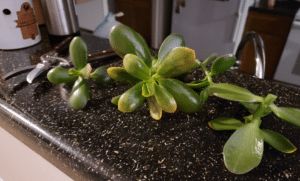The Jade plant (Crassula ovata) is an evergreen succulent widely admired for its thick, glossy, and smooth foliage.
Besides being an easy-to-care plant, you should provide favorable conditions to allow this plant to decorate your gardens.
Here, I have the ultimate guide to caring for Jade plants outdoors.
Table of Contents Show
What Are Some Good Uses of Jade Plants Outdoors?
- These succulents make beautiful hedges. Likewise, you can also keep them clipped and use them as border plants.
- Any leaf cutting that falls to the ground or comes into contact will likely take root and grow into a new plant.

- For a less formal, more natural look, Jade plants can be allowed to grow into colonies.
- They can also be fashioned into one-of-a-kind bonsai specimens.
If Grown Outdoors, Do Jade Plants Need a Lot of Care?
Jade plants need some additional care if you decide to keep them outdoors.
However, if you provide a healthy living environment, Jade plants will thrive more outdoors.
- If you live somewhere with cold climates throughout the year, you must keep periodically shifting Jade plants indoors.
- Splashing water on the leaves can cause them to rot. So, carefully monitor them while watering other plants in your garden.
- Commonly, infestations are caused by bugs carried in from outside or introduced by other plants near it.
12 Points to Remember While Caring for a Jade Plant Outdoors
Jade plants are resilient pieces on their own. They fancy being in areas with bright sunlight, which is usually outdoors.
Nevertheless, considering the following factors can benefit your Jade plant.
1. Sunlight & Temperature
An excellent outdoor site is a slightly shaded area that gets good exposure to morning sunlight and blocks scorching heat in the afternoon.
Nonetheless, more than 7 hours of scorching heat with an excessive temperature can induce burnt brown spots on the leaves.
If you have time, try giving your Jade plant a quarter rotation every week to ensure even growth on all sides.
Your Jade plant may become droopy if it remains exposed to cold temperatures for an extended period.
However, it is recommended that plants in their early stages be kept in indirect sunlight to avoid the leaves from getting burnt.
When Jade plants receive enough sunlight, leaf tips turn slightly reddish.
Tips to Provide Proper Heat & Temperature
- To avoid frost damage, it’s wise to put them indoors when the temperature dips below 50°F or throughout the fall and winter.
- Also, you can use a frost blanket.
- Keep your plants 2-3 feet away from the window to prevent direct bright sunlight.
- Place your plants outdoors during cold days to provide enough sunlight.
2. Watering & Humidity
Jade plants demand more water in spring and summer, but you should always let the soil dry up before watering it again.
If the leaves begin to curl or turn brown, it would be time to water more frequently. However, it’s time to stop if the leaves feel too spongy.
Improper watering results in root rots, yellowing and browning of foliage, and drooping of the entire plant.
Similarly, shriveling, browning, and wrinkling are the symptoms of improper humidity.
Tips to Provide Proper Watering & Humidity
- For low humidity signs, mist the plants or use a room humidifier.
- Increase the watering frequency during hotter days.
- Place a water-filled pebble tray under the planter.
- Use a moisture meter to determine the amount of moisture in your soil.
3. Soil & Fertilizers
Provide Jade plants with a cactus and succulent fertilizer once a month.
Organic fertilizers such as fish emulsion provide adequate nitrogen for Jades to prosper. However, liquid fertilizers are the most convenient for your Jade plant.
Just make sure to select a formula designed specifically for cacti and succulents.
However, overfertilization results in the burning of foliage and roots of the plants.
Yellowing, drooping, and stunting of the plants are the symptoms of inadequate feeding.
Tips to Provide Proper Soil & Fertilization
- When using a liquid fertilizer, never apply it to dry soil, affecting the plant’s root structure.
- If you see the salt accumulating in the soil, flush out the salt with distilled water.
- For better absorption of fertilizers, wet the soil one day before fertilizing.
- Miracle-Gro and Burpee are some commercial fertilizer recommendations.
4. Scantly Pruning
Prune your Jade plant once a year during Spring or Summer to promote the plant’s growth to its best.
Pruning dead & damaged parts prevent the outspread of diseases to healthy plant parts.
The important pests disturbing the growth of plants are Mealybugs, Spider mites, and Aphids.
They suck out plant nutrients, resulting in yellowing, browning, and stunting of plant parts.
Similarly, major plant diseases are Bacterial soft rot, Powdery mildew, and Black ring disease.
Pruning the infected parts help to recover the plant from disease damage.
Tips to Prune Properly
- Firstly, inspect the damaged plant parts and cut them with sterilized scissors.
- To prevent microbial invasion from cut ends, apply Neem oil.
- Remember to disinfect the pruning tools after the work has been done.
- Apply Copper-fungicides to the soil in 2-3 weeks intervals.
- Wear gloves during pruning to prevent allergic reactions due to the plant’s toxicity.
5. Frequent Repotting
If you provide the best conditions for your plant, it will grow outdoors about 2 to 3 inches annually.
Then, slowly but surely, the pot will become too small to support vast root structures and the heavy top of the plant.

Their development will halt if their pot becomes too tiny. Therefore, it is a suitable method if you want to keep the size of the plant small and manageable.
Nonetheless, it is still recommended to repot Jade plants as it allows the roots to absorb nutrients in the soil better.
Older Jade can be repotted every 4 to 5 years or as required. It would be beneficial if you performed whatever your plant seemed to require.
Tips to Repot Properly
- Firstly, remove the plant from the container.
- Apply fungicide to damaged plant parts and soil.
- Repot in the Terracotta pots with the suitable soil mix.
- Place the pots in indirect bright sunlight avoiding overexposure to sunlight.
How to Grow a Jade Plant Into a Tree
The major footsteps to growing a Jade plant into a tree are:
1. Select a Right Pot
A 6-14″ Terracotta pot is best for the Jade plant to grow into a tree.
This will help provide the plant with more space to expand.
2. Train the Trunk
Use the main stem as the main trunk and trim side branches.
Doing so will encourage the plant to use stored nutrients from the trunk and allows the plant to spire higher.
3. Provide Direct Bright Sunlight
Being a succulent, the Jade plant stores plenty of water in its leaves and is more prone to microbial infections.
So, it needs 4-6 hours of direct, bright sunlight to prevent rots.
Moreover, sunlight exposure must be equally distributed from the top of the plant to the bottom.
On top of that, the Jade plant needs all the favorable conditions mentioned above to grow into a tree.
Can a Jade Plant Survive Outdoors in Winter?
These plants can get frost damage if exposed to frigid temperatures. The plant might appear limp, and the leaves may turn black.
In severe cases, the leaves may even begin to fall. Frost can also influence the leaves to rot.
Jade plants can bear 45-55°F in the winter.
If you live in an area that doesn’t get freezing climates, you can put your Jade plant outdoors.
You can protect the plant from occasional cold temperatures by moving it to a covered patio and covering it with thin fabric.
However, if you live in a region that constantly stays cold in the winter, it is better to raise the plant indoors.
From Editorial Team
Conclusion!
With some practice, you might want to buy more Jade plants or even want to try out plants with similar features.
Caring for Jade plants outdoors is not as hard as it might sound, right? I hope that this article clears all your questions.
You can now set out to raise your Jade plant efficiently.
However, some disadvantages of Jade plants are rare flowering and are more susceptible to rots.


